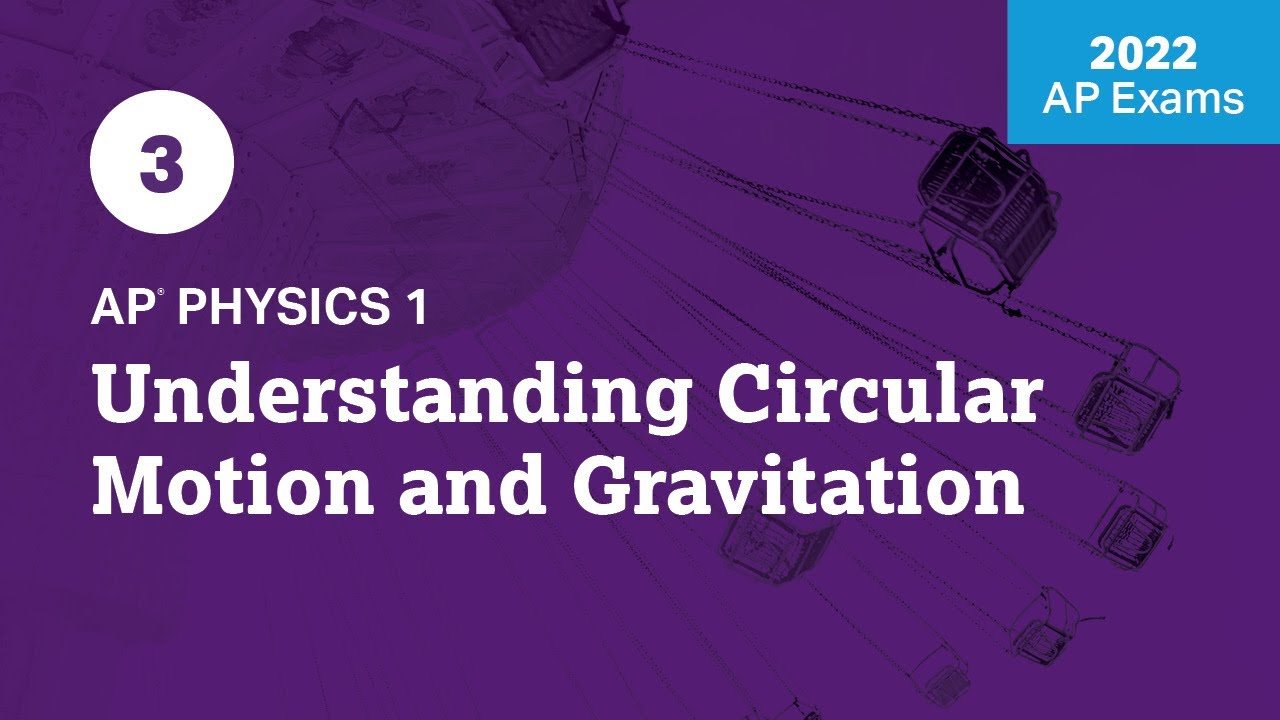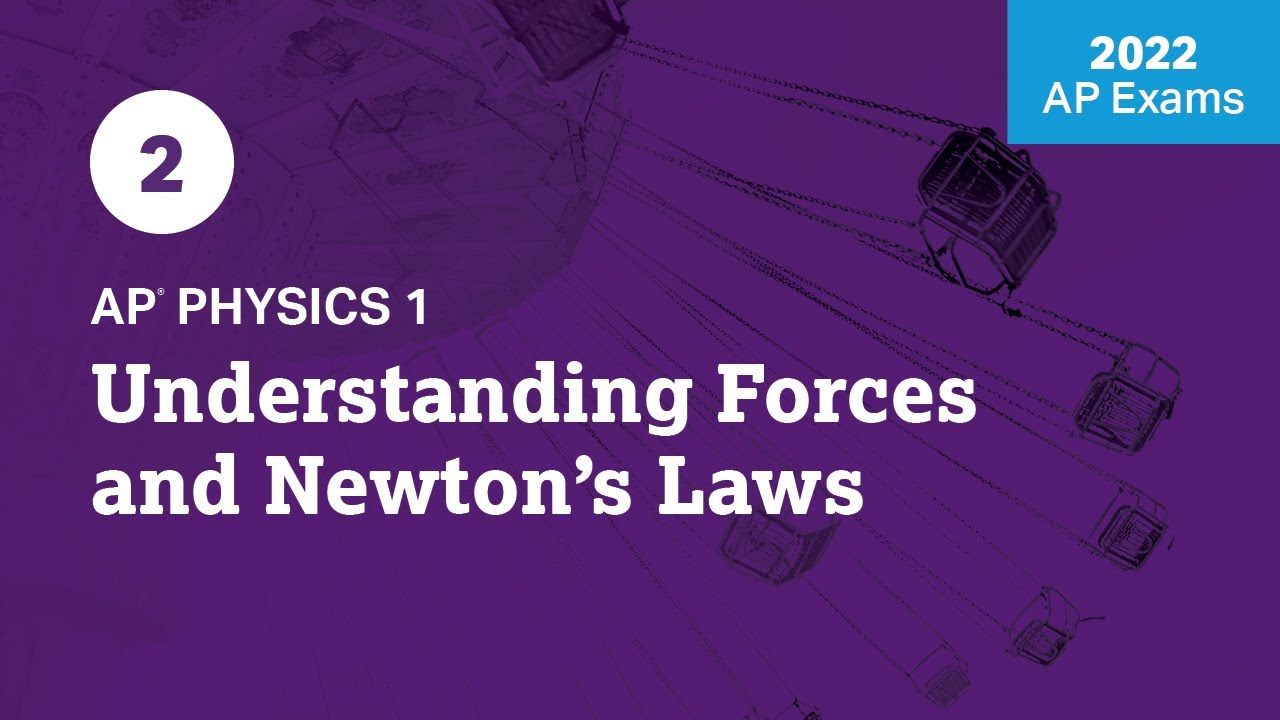2022 Live Review 1 | AP Physics 1 | Understanding Motion and Kinematics
TLDRIn this comprehensive review session, Brian Brown delves into the key concepts of kinematics, focusing on position, velocity, and acceleration. He emphasizes the importance of defining frames of reference and discusses the significance of using motion diagrams and graphs to understand and solve problems related to an object's motion. Through practical examples and potential exam questions, Brown provides valuable insights and strategies for tackling kinematics problems in the AP Physics 1 exam.
Takeaways
- 📍 Understand kinematics by answering three key questions: position, velocity, and acceleration of an object.
- 📏 Define a frame of reference to clearly describe an object's position and establish the positive direction for measurements.
- 🔄 Displacement (Δx) is the change in position (final minus initial) and can be positive or negative depending on the direction of movement.
- 📈 Velocity is the rate of change of position and is vector quantity, meaning it has both magnitude and direction.
- 🚀 Acceleration is the rate of change of velocity and is also a vector, indicating how quickly the velocity is changing, not just the speed of the object.
- 📊 Use motion diagrams and graphs (position-time, velocity-time, and acceleration-time) to visualize and analyze motion.
- 🤹♂️ Differentiate between average and instantaneous values for velocity and acceleration, which are crucial for solving problems accurately.
- 🔢 Apply the correct kinematic equations for constant acceleration or velocity scenarios, and recognize when they cannot be used.
- 🎥 For the AP Physics 1 exam, be prepared to translate real-world scenarios into diagrams, graphs, and numerical problems.
- 🛠️ Practice sketching motion diagrams and graphs to enhance problem-solving skills and to better understand the concepts of kinematics.
- 📝 Memorize definitions and key equations, as they are essential for both conceptual understanding and for solving problems on the AP Physics 1 exam.
Q & A
What are the three questions kinematics answers about an object's motion?
-Kinematics answers where the object is (its position), how fast its position is changing (its velocity), and how fast its velocity is changing (its acceleration).
How do you define a frame of reference for linear motion?
-For linear motion, you choose a single axis depending on the direction of movement: x for horizontal and y for vertical. The zero position or origin and the positive direction must be defined for consistency.
What is displacement and how is it different from position?
-Displacement is the change in an object's position, represented by the symbol delta x, and is calculated as the final position minus the initial position. Position, on the other hand, is the specific location of the object at a given time.
What is the technical definition of velocity?
-Velocity is the rate at which an object's position is changing, and it is related to displacement over a given time interval.
How can you determine the direction of an object's acceleration?
-Acceleration's direction is determined by whether the velocity of the object is increasing or decreasing, and whether the change is in the positive or negative direction relative to the chosen frame of reference.
What are the two types of velocity and how do they differ?
-The two types of velocity are average velocity and instantaneous velocity. Average velocity is the displacement over a time interval, while instantaneous velocity is the speed of the object at a specific moment in time.
What is the significance of the slope in a position-time graph?
-The slope in a position-time graph represents the average velocity of the object. A straight line with a constant slope indicates constant velocity motion.
How can you interpret the area under a velocity-time graph?
-The area under a velocity-time graph represents the displacement during a specific time interval. The sign of the area (positive or negative) indicates the direction of the displacement.
When can you use the equations provided on the AP Physics 1 equation sheet?
-You can use the equations on the AP Physics 1 equation sheet when dealing with constant acceleration scenarios. If the acceleration is not constant, these equations do not hold true.
What is the relationship between the final velocity, initial velocity, acceleration, and displacement in the context of constant acceleration?
-The equation v^2 = u^2 + 2as relates the final velocity (v), initial velocity (u), acceleration (a), and displacement (s) in scenarios with constant acceleration.
How can you conceptually solve kinematics problems without extensive math?
-By using motion diagrams and graphs, you can conceptually solve kinematics problems by visualizing the motion, understanding the relationships between velocity, acceleration, and displacement, and applying these concepts to the given scenarios.
Outlines
📚 Introduction to Kinematics
This paragraph introduces Brian Brown and sets the stage for a review of AP Physics 1 topics, focusing on kinematics. Brian explains that kinematics answers three fundamental questions about an object's motion: its position, velocity, and acceleration. The paragraph emphasizes the importance of understanding these concepts from different perspectives, including defining terms, analyzing equations, and interpreting graphs. It also mentions the distinction between the AP Physics 1 equation sheet and other equations not included in the exam. The discussion begins with the concept of position and the necessity of defining a frame of reference for accurate measurements.
🏃♂️ Velocity and Acceleration
In this paragraph, Brian delves into the concepts of velocity and acceleration. Velocity is defined as the rate of change of position, with a positive or negative value indicating direction. Acceleration, on the other hand, is the rate of change of velocity and is represented by the velocity vectors in motion diagrams. The paragraph explains how to interpret these diagrams and understand the direction of acceleration relative to the object's motion. Brian also clarifies the difference between average and instantaneous values of velocity and acceleration, emphasizing the importance of recognizing when each is applicable.
📈 Understanding Graphs in Kinematics
This paragraph discusses the significance of graphs in kinematics, particularly position-time and velocity-time graphs. Brian explains how to interpret these graphs, including understanding the slope as a measure of velocity or acceleration and the area under the graph as a representation of displacement. The paragraph highlights the importance of recognizing the type of motion—constant velocity or constant acceleration—through the shape of the graph. It also touches on the concept of using graphs to solve problems without extensive mathematical calculations.
🎥 Applying Kinematics to Real-World Motion
Brian uses a real-world example of a ping-pong ball bouncing on a table to demonstrate how to apply kinematic principles. He outlines the process of creating a reference frame, analyzing the motion, and translating observations into a motion diagram and graphs. The paragraph emphasizes the importance of understanding the acceleration due to gravity and how it affects the motion of the ball. Brian also discusses the challenges of representing complex motion, such as the ball's interaction with the table, in a simple graph.
📊 Analyzing Motion with Graphs
This paragraph continues the discussion on using graphs to analyze motion. Brian focuses on the acceleration graph for the ping-pong ball example, explaining how to derive the graph from the velocity graph. He also discusses the position-time graph and its parabolic shape, which reflects the object's accelerating and decelerating phases. The paragraph emphasizes the importance of understanding the relationship between the graphs and the physical quantities they represent, such as displacement and acceleration.
🤔 Solving Kinematics Problems
Brian provides guidance on solving kinematics problems, emphasizing the importance of sketching motion diagrams and graphs to visualize the motion and understand the underlying physics. He discusses the difference between one-dimensional and two-dimensional problems and provides strategies for tackling each. The paragraph also covers the concept of constant velocity and acceleration, and how to apply these concepts to solve problems. Brian encourages the use of quick sketches to gain insights into the motion without extensive calculations.
🚀 Rocket Motion and Graph Analysis
In this paragraph, Brian presents a complex kinematics problem involving a rocket's ascent and descent. He explains how to create an acceleration-time graph, a velocity-time graph, and how to determine the rocket's maximum height using the area under the velocity-time graph. The paragraph highlights the importance of recognizing the different phases of motion—constant acceleration and free fall—and how to apply the appropriate equations for each phase. Brian also addresses common mistakes in solving such problems, such as incorrectly assuming constant acceleration throughout the entire motion.
📝 Key Points in Kinematics
Brian concludes the video by summarizing the key points from the discussion on kinematics. He emphasizes the importance of sketching motion diagrams and graphs to aid in understanding and problem-solving. The paragraph reiterates the significance of distinguishing between constant velocity and constant acceleration scenarios and the need to separate motion into horizontal and vertical components for projectile problems. Brian also stresses the importance of knowing definitions and being familiar with the AP Physics 1 equation sheet. He encourages practice and provides reassurance that with understanding and application, viewers will be well-prepared for their exams.
Mindmap
Keywords
💡Kinematics
💡Position
💡Velocity
💡Acceleration
💡Displacement
💡Reference Frame
💡Motion Diagrams
💡Average Velocity
💡Instantaneous Velocity
💡Free Fall
💡Projectile Motion
Highlights
The program focuses on reviewing AP Physics 1 topics, specifically kinematics.
Kinematics answers three fundamental questions about an object's motion: position, velocity, and acceleration.
The course stops with the definition of acceleration, not delving into how fast an object's acceleration changes.
The importance of defining a frame of reference when discussing an object's position is emphasized.
Displacement is defined as the change in an object's position (final minus initial).
Velocity is the rate at which an object's position changes, and it is dependent on the defined frame of reference.
Acceleration is the change in velocity, which can be positive or negative depending on the direction of change.
Deceleration is a type of acceleration (negative acceleration) that indicates a decrease in velocity.
Average and instantaneous values of velocity and acceleration are discussed, with their respective equations provided.
The use of graphs, such as position-time and velocity-time graphs, is highlighted for understanding motion.
The area under a velocity-time graph represents displacement during specific time intervals.
The program includes a practical example of a ping-pong ball bouncing to illustrate the concepts of kinematics.
The importance of sketching motion diagrams and graphs for problem-solving in kinematics is emphasized.
Key kinematic equations are reviewed, with clarification on which ones are on the AP Physics 1 equation sheet.
The program concludes with a series of practice problems to apply the learned concepts of kinematics.
The concept of constant velocity and constant acceleration is clarified, with examples provided.
The significance of understanding the definitions of terms like displacement, velocity, and acceleration is highlighted for problem-solving.
Transcripts
Browse More Related Video

AP Physics 1 | Unit 1: Kinematics

2022 Live Review 3 | AP Physics 1 | Understanding Circular Motion and Gravitation

2022 Live Review 2 | AP Physics 1 | Understanding Forces and Newton’s Laws

AP Physics 1: Kinematics Review

College Physics 1: Lecture 6 - Representing Position and Velocity

How to Cram Kinematics in 1 hour for AP Physics 1
5.0 / 5 (0 votes)
Thanks for rating: